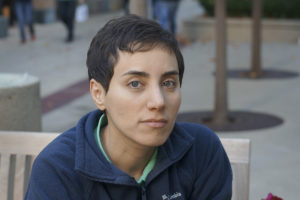7th Aug, 2017
On Friday, I was casually exploring Quanta magazine, a place I go to from time to time to get some readable in-depth coverage of the happenings in the math and science world. About half-page down, I found a title that indicated math, but I only read the first sentence before I was in shock and disbelief. It spoke of the death of Maryam Mirzakhani. Questions raced my mind. Did I get the name right? Was it the same person or was it some older relative of her with the same name? A little more reading unfortunately confirmed the tragic truth.
Maryam Mirzakhani had died of cancer. She was 40.
Maryam Mirzakhani was the first woman to receive the Field’s medal. As some readers might know, there is no Nobel prize for mathematics, and Field’s medal is regarded the Nobel prize of mathematics. Some regard Field’s medal to be tougher to get than the Nobel prize because it is awarded only once in four years, and only those under 40 are eligible. Maryam Mirzakhani was also the first Iranian to be awarded the Field’s medal. She received the Field’s medal in 2014. She was 37 then.
In 2014, when the list of the four Field’s medal awardees was announced, one awardee stood out for me: Manjul Bhargava. Of course, the name was Indian. Secondly, I had already seen a video of Manjul Bhargava before, a video in which he was introducing another famous mathematician. With thick glasses and nerdy laugh, he seemed to fit the mathematician stereotype, but his talk in that video was non-mathematical. And, his hobby was playing music (tabla), and he studied poetry (Sanskrit). With all this, he seemed somewhat familiar and accessible to non-mathematicians.
On the other hand, the name Maryam Mirzakhani was practically unknown until news broke out in August 2014 that she was given the Field’s medal. What was so remarkable about the genius of this young woman and her work that she deserved this award? In the picture of her that was published, there was no smile on her face, but her face emanated depth, determination and humility.

A 2-minute video that came out a short while after gave me an impression that she talked less, and spent more time deep in mathematical thought. I was hoping that as time went by we would see more of her presence in talks and articles, and we in the wider mathematical world could relate to her more. But, since she was quite young, there was a lot of time for us to connect to her. Or, so I thought.
Now, within three years, we have news of her death. I am in denial.
Her work was on hyperbolic geometry and dynamical systems, areas that I do not know anything about to be able to comment meaningfully on her work.
I can however comment on her style. She described herself as a slow mathematician. Others translate this to mean a persevering and a thorough mathematician. I tend to agree. Research in mathematics (pure mathematics, in particular) is hard. In school, when you are given a problem to solve, you know that a solution to the problem exists, and you likely just have to apply techniques that were used to solve similar problems. That is not so in research. You choose your problems. Sometimes, you create your own problems. Sometimes, you do not know that a solution exists, let alone that you will find the solution. And, you do not have a supervisor who has the answers. You are on your own. Yet, you persevere. What keeps you going is the beauty in mathematics and in the pursuit of it. You create problems that hold keys to unlock beautiful hidden abstract structures. If you find solution to a problem, you likely unfold a beautiful mathematical structure. If you try but fail to find any solution, you discover enough things along the way that are equally beautiful. I believe Maryam Mirzakhani was on a steady path in the pursuit of beauty when she spent decades “slowly” working on her problems.
It is nice to visit your blog and learn about Maryam . Its a sad news that she died so young but her contribution to mathematics will be remembered ever . All the more important it is time to highlight Maryam ‘ intelligence and skill with numbers when questions are being raised on womens diversity in workplace and their contribution to non-art related subjects. Remembering Maryam and very well -written article Sandeep .
👌
Great article written in the glory of lesser known genius, pride of womanhood and A humble short lived soul. Learning is a life long pursuit. For sure, we all could have benefited if she lived longer. The article steers the conversation into how a PhD student solves math problems. In fact, that’s true with everyone in regular life.